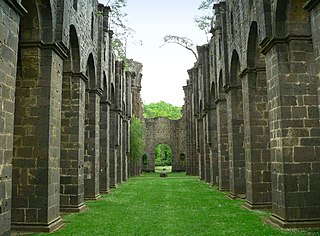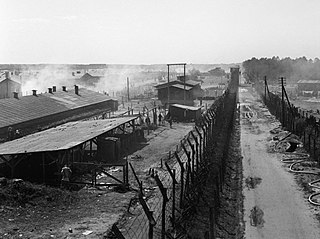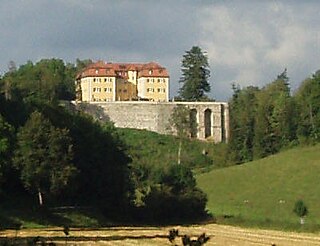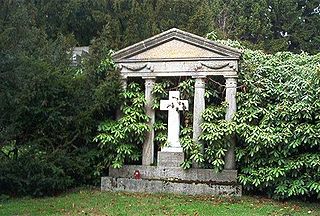 W
WThe Aegidienkirche was a church in Hanover, the capital of Lower Saxony, Germany. It was one of three churches in the Old Town, the others being the Marktkirche and the Kreuzkirche. It was destroyed in World War II, and was left in ruins as a war memorial.
 W
WArnsburg Abbey is a former Cistercian monastery near Lich in the Wetterau, Hesse, Germany. It was founded by monks from Eberbach Abbey in 1174. Although heavily damaged in the Thirty Years' War it was rebuilt later in the 17th century and prospered in the 18th century, when much of the abbey was rebuilt in Baroque style.
 W
WThe Becklingen War Cemetery is a military cemetery located in the state of Lower Saxony in north Germany on the Lüneburg Heath. It was built by the Commonwealth War Graves Commission who continue to look after it today. The cemetery lies near Getrudenhof near the village of Becklingen and just north of the British Army base of Hohne Station where the Headquarters of 7th Armoured Brigade and several brigade units were based until 2015, when the brigade moved back to the UK.
 W
WBergen-Belsen [ˈbɛʁɡn̩.bɛlsn̩], or Belsen, was a Nazi concentration camp in what is today Lower Saxony in northern Germany, southwest of the town of Bergen near Celle. Originally established as a prisoner of war camp, in 1943, parts of it became a concentration camp. Initially this was an "exchange camp", where Jewish hostages were held with the intention of exchanging them for German prisoners of war held overseas. The camp was later expanded to accommodate Jews from other concentration camps.
 W
WDachau was a Nazi concentration camp opened in March 1933, which was initially intended to hold political prisoners. It is located on the grounds of an abandoned munitions factory northeast of the medieval town of Dachau, about 16 km (10 mi) northwest of Munich in the state of Bavaria, in southern Germany. After its opening by Heinrich Himmler, its purpose was enlarged to include forced labor, and, eventually, the imprisonment of Jews, German and Austrian criminals, and finally foreign nationals from countries that Germany occupied or invaded. The Dachau camp system grew to include nearly 100 sub-camps, which were mostly work camps or Arbeitskommandos, and were located throughout southern Germany and Austria. The main camp was liberated by U.S. forces on 29 April 1945.
 W
WThe Grafeneck Euthanasia Centre housed in Grafeneck Castle was one of Nazi Germany's killing centres as part of their forced euthanasia programme. Today, it is a memorial site dedicated to the victims of the state-authorised programme also referred to since as Action T4. At least 10,500 mentally and physically disabled people, predominantly from Bavaria and Baden-Württemberg, were systematically killed during 1940. It was one of the first places in Nazi Germany where people were killed in large numbers in a gas chamber using carbon monoxide. This was actually the beginning of the Euthanasia Programme. Here was also settled the central office of "Charitable Ambulance Transport GmbH" (Gekrat), which was responsible for the transport of T4 and was headed by Reinhold Vorberg.
 W
WHamburg Commonwealth War Graves Commission Cemetery is a war cemetery which was built and is looked after by the Commonwealth War Graves Commission (CWGC). The war graves of 676 Commonwealth service personnel from World War I and 1,889 from World War II are located near Chapel 12 in the greater Ohlsdorf Cemetery in the Ohlsdorf quarter of Hamburg.
 W
WHebertshausen shooting range was a shooting range at Dachau concentration camp, located two kilometres north of the Dachau main camp for SS guards that used Soviet live prisoners of war as targets. It was built in 1937-38 as an expansion to Dachau concentration camp. Between 1941 and 1942, more than 4,000 Soviet prisoners were murdered on the site. These were mainly officers, communist officials, and Jews. The victims were “singled out” according to ideological and racist criteria by Gestapo Einsatzkommandos in the POW camps of the military districts of Munich, Nuremberg, Stuttgart, Wiesbaden and Salzburg. After World War II, American troops assumed control of the site and continued to use it as a firing range. It is now a memorial to Nazi victims.
 W
WThe Memorial to the Murdered Members of the Reichstag is a memorial in Berlin, Germany. The memorial is located in front of the Reichstag building, and commemorates the 96 members of the parliament who died unnaturally between 1933 and 1945 (1948). The idea of creating the monument started in the 1980s, and the memorial was erected in September 1992. It was designed by Dieter Appelt, Klaus W. Eisenlohr, Justus Müller and Christian Zwirner. The memorial is made of 96 cast iron plates, with the names, birth and death dates and places engraved on the edges. It has been designed so that it can be extended if new names are discovered in the future.
 W
WThe U-Boot-Ehrenmal Möltenort in Heikendorf near Kiel is a memorial site belonging to the German War Graves Commission, commemorating the sailors who died serving in U-Boat units during the First and Second World Wars, along with all victims of submarine warfare. The memorial also honours U-Boat sailors from the Bundeswehr who have been killed in action since. The memorial site is an emblem of Heikendorf.
 W
WOhlsdorf Cemetery in the Ohlsdorf quarter of the city of Hamburg, Germany, is the biggest rural cemetery in the world and the fourth-largest cemetery in the world. Most of the people buried at the cemetery are civilians, but there is also a large number of victims of war from various nations. The cemetery notably includes the Old Hamburg Memorial Cemetery with the graves of many notable Hamburg citizens.
 W
WRavensbrück was a German concentration camp exclusively for women from 1939 to 1945, located in northern Germany, 90 km (56 mi) north of Berlin at a site near the village of Ravensbrück. The camp memorial’s estimated figure of 132,000 women who were in the camp during the war includes about 48,500 from Poland, 28,000 from the Soviet Union, almost 24,000 from Germany and Austria, nearly 8,000 from France, and thousands from other countries including a few from the United Kingdom and the United States. More than 20,000 of the total were Jewish. More than 80 percent were political prisoners. Many slave labor prisoners were employed by Siemens & Halske. From 1942 to 1945, medical experiments to test the effectiveness of sulfonamides were undertaken.
 W
WSachsenhausen or Sachsenhausen-Oranienburg was a Nazi concentration camp in Oranienburg, Germany used from 1936 to the end of the Third Reich in May 1945. It mainly held political prisoners throughout World War II. Prominent prisoners include Joseph Stalin's oldest son Yakov Dzhugashvili, assassin Herschel Grynszpan, Paul Reynaud the penultimate Prime Minister of France, Francisco Largo Caballero Prime Minister of the Second Spanish Republic during the Spanish Civil War, the wife and children of the Crown Prince of Bavaria, Ukrainian nationalist leader Stepan Bandera, and several enemy soldiers and political dissidents.